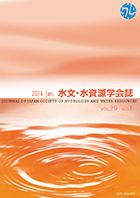Volume 29, Issue 1
Displaying 1-16 of 16 articles from this issue
- |<
- <
- 1
- >
- >|
-
2016Volume 29Issue 1 Pages 1-4
Published: January 05, 2016
Released on J-STAGE: April 15, 2016
Download PDF (256K)
-
2016Volume 29Issue 1 Pages 5-8
Published: January 05, 2016
Released on J-STAGE: April 15, 2016
Download PDF (386K) -
2016Volume 29Issue 1 Pages 9-10
Published: January 05, 2016
Released on J-STAGE: April 15, 2016
Download PDF (151K) -
2016Volume 29Issue 1 Pages 11
Published: January 05, 2016
Released on J-STAGE: April 15, 2016
Download PDF (153K) -
2016Volume 29Issue 1 Pages 12-14
Published: January 05, 2016
Released on J-STAGE: April 15, 2016
Download PDF (244K) -
2016Volume 29Issue 1 Pages 15-21
Published: January 05, 2016
Released on J-STAGE: April 15, 2016
Download PDF (558K) -
2016Volume 29Issue 1 Pages 22-31
Published: January 05, 2016
Released on J-STAGE: April 15, 2016
Download PDF (92K)
Original research article
-
2016Volume 29Issue 1 Pages 32-43
Published: January 05, 2016
Released on J-STAGE: April 15, 2016
Download PDF (2671K) -
2016Volume 29Issue 1 Pages 44-54
Published: January 05, 2016
Released on J-STAGE: April 15, 2016
Download PDF (1636K)
-
2016Volume 29Issue 1 Pages 55-56
Published: January 05, 2016
Released on J-STAGE: April 15, 2016
Download PDF (217K) -
2016Volume 29Issue 1 Pages 57-67
Published: January 05, 2016
Released on J-STAGE: April 15, 2016
Download PDF (1056K)
-
2016Volume 29Issue 1 Pages 68-72
Published: January 05, 2016
Released on J-STAGE: April 15, 2016
Download PDF (580K) -
2016Volume 29Issue 1 Pages 73-78
Published: January 05, 2016
Released on J-STAGE: April 15, 2016
Download PDF (620K) -
2016Volume 29Issue 1 Pages 79-84
Published: January 05, 2016
Released on J-STAGE: April 15, 2016
Download PDF (436K)
-
2016Volume 29Issue 1 Pages 85
Published: January 05, 2016
Released on J-STAGE: April 15, 2016
Download PDF (155K)
-
2016Volume 29Issue 1 Pages 86
Published: January 05, 2016
Released on J-STAGE: April 15, 2016
Download PDF (176K)
- |<
- <
- 1
- >
- >|
